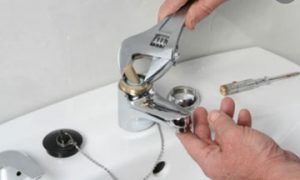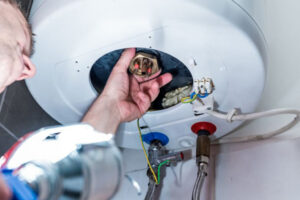If you have noticed your water becoming more lukewarm than hot, there’s a good chance that your water heater has lost some of its efficiency. Calcium and magnesium deposits accumulate in this equipment as time passes, particularly if the water is hard, which lowers their heating capacity. To prevent this problem from happening to you, your unit should be drained and flushed at least once a year. It is important to know how to drain and flush your water heater, as well as what issues can arise if you do this yourself.
1. Shut off the power and water to the equipment
This is always the first step in working on your water heater. For gas units, the gas regulation knob should be switched to the “Pilot” setting. For electric units, the circuit breaker on the main fuse box must be switched off and the power plug disconnected. Shutting off the cold-water supply is the next step, which generally requires nothing more than twisting the control lever 90 degrees.
2. Turn on a hot water faucet just before flushing the unit
Turning on the hot water in a nearby sink in your home will prevent a vacuum from building up in the pipes and allowing air in. This step makes it easier to drain the equipment. The faucet should stay on while the water heater is draining.
3. Connect a drainage hose to the water heater
Wearing gloves to protect against burns is a good idea during this step. The hose should be attached to the unit’s drainage valve and run to the ground outside the home, a bucket, or other drainage receptacle. Heaters that are located below ground or in basements may need a hand pump attached to the drainage line. Another tube should be hooked up to the pump that runs to the bucket or outside ground if this is the case.
4. Drain the reservoir of the water heater
Opening the drainage valve permits the water to run into the hose until the tank is emptied. Before performing this step, the water heater must cool down adequately so that the water entering the drainage bucket isn’t too hot.
5. Flush out the reservoir
Now, any silt or sediment still lingering at the bottom of the tank can be flushed out by opening the cold supply valve. Twisting the knob from open to close a few times should help loosen up any residue. Remember, water flows out very rapidly when this valve is reopened. When no more sediment seeps out of the hose and the running water appears to be clear, you can close the drain valve.
After the cold supply knob has been flipped to “open,” all hot water faucets in the home should be turned on. This step will eliminate any air pockets from the line.
6. Turn the power to the water heater back on
Owners of gas units should follow the supplier’s guidelines when relighting units. However, the safest way to turn the gas back on is to hire an experienced plumbing company. The instructions are usually printed in the user’s handbook and directly on the unit itself. The heater tank should always be refilled before the gas or electrical contacts are turned back on to prevent damage to the heating coil.
To make sure a water heater runs at maximum efficiency, most experts recommend flushing the reservoir and performing general maintenance at least once a year. Older gas units that have never been flushed before are often better off being professionally serviced for safety purposes.
Issues that can occur when working on a water heater yourself
Over a period of years, accumulated sediment may have damaged the metal reservoir and/or glass liner of your water heater. Some of the sediment may be plugging up tiny gaps in the metal. If this is the case, flushing the reservoir out will likely remove this leak-sealing sediment and lead to much more severe issues.
Professional plumbers are experienced in draining and flushing this equipment, so they are familiar with any issues that can occur during the process. Plumbers know when to watch for hot water and when to be sure that no water will seep out of the unit. Plumbers can also repair any current issues with your water heater and prevent worse problems from happening in the future.
If you are uncertain about draining and flushing your water heater, the specialists at Cole’s Plumbing. We take advantage of the most advanced tools to analyze and restore gas or electric water heaters. Our plumbing experts provide the best services in Denton & Collin Counties at the best prices. Call/text us today at (972) 210-9033 or complete the Get an Estimate form to learn more about how we can help you.







